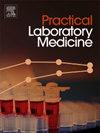老年人群中的1,25-二羟基维生素D:液相色谱串联质谱法和CLIA免疫分析法(LIAISON®XL)方法的比较
IF 1.7
Q3 MEDICAL LABORATORY TECHNOLOGY
引用次数: 0
摘要
α,25-二羟基维生素D是维生素D3(胆钙化醇)和维生素D2(麦角钙化醇)的生物活性形式。1,25(OH)2D的测定在诊断维生素D代谢紊乱、甲状旁腺素非依赖性高钙血症和低磷血症综合征方面具有临床意义。125 (OH)2D的定量评估可能是一个挑战,因为它在血液中以皮摩尔浓度循环。研究目的比较化学发光免疫分析法(CLIA, LIAISON®XL)和液相色谱串联质谱法(LC-MS/MS)测定老年人体内1,25(OH)2D浓度的方法。第二个目的是评估CLIALIAISON®XL和LC-MS/MS方法中1,25(OH)2D与选定因素(维生素D代谢物、钙、白蛋白、甲状旁腺激素、血清肌酐浓度和年龄)之间的相关性。材料与方法该研究在波兰华沙Bielański医院对54名年龄从60岁到96岁的患者进行了研究。采用CLIALIAISON®XL和LC-MS/MS法测定1,25(OH)2D。结果CLIALIAISON®XL免疫分析法与LC-MS/MS技术呈正相关(r = 0.86;p & lt;0.001)。在LC-MS/MS技术中,与CLIALIAISON®XL免疫分析法相比,125 (OH)2D的浓度显著升高。回归方程显示了方法的互换性。两种方法的1,25(OH)2D浓度与各种基本生化参数(白蛋白和钙水平)均显著相关。结论在我们的研究中,CLIALIAISON®XL测量1,25(OH)2D的效果不逊于LC-MS/MS。CLIALIAISON®XL检测1,25(OH)2D具有周转时间短、成本低、准确性高的特点,可能是需要及时诊断和治疗的老年患者的最佳选择。本文章由计算机程序翻译,如有差异,请以英文原文为准。
1,25-dihydroxyvitamin D in the elderly population: Comparison of liquid chromatography tandem mass spectrometry and CLIA immunoassay (LIAISON®XL) methods
Background
1α,25-dihydroxyvitamin D is the biologically active form of vitamin D3 (cholecalciferol) and vitamin D2 (ergocalciferol). The determination of 1,25(OH)2D is clinically relevant in the diagnostics of vitamin D metabolism disorders, PTH-independent hypercalceamia and hypophosphatemic syndromes. The quantitative assessment of 1,25(OH)2D may be a challenge since it circulates in picomolar concentrations in the blood.
Aims of the study
Comparison of two methods: chemiluminescent immunoassay (CLIA, LIAISON®XL) and Liquid Chromatography Tandem Mass Spectrometry (LC-MS/MS) for determinations of 1,25(OH)2D concentrations in elderly populations. The secondary aim was to assess correlation between 1,25(OH)2D for CLIALIAISON®XL and LC-MS/MS methods and selected factors (vitamin D metabolites, calcium, albumin, PTH, creatinine concentrations in serum and age).
Materials and methods
The study was conducted on 54 patients aged from 60 to 96 at the Bielański Hospital in Warsaw, Poland. The determination of 1,25(OH)2D using CLIALIAISON®XL and LC-MS/MS methods was performed.
Results
Both methods (CLIALIAISON®XL immunoassay and LC-MS/MS technique) were strongly positively correlated (r = 0.86; p < 0.001). In the LC-MS/MS technique, concentration of 1,25(OH)2D was significantly higher compared to the CLIALIAISON®XL immunoassay. The regression equation revealed method interchangeability. Concentration of 1,25(OH)2D was significantly correlated with various basic biochemical parameters (albumin and calcium levels) for both methods.
Conclusions
In our study, measurement of 1,25(OH)2D using CLIALIAISON®XL was not inferior to LC-MS/MS measurement. The assessment of 1,25(OH)2D using CLIALIAISON®XL, characterized by short turnaround time, low costs and high accuracy, may be an optimal choice for elderly patients who often require prompt diagnosis and treatment.
求助全文
通过发布文献求助,成功后即可免费获取论文全文。
去求助
来源期刊

Practical Laboratory Medicine
Health Professions-Radiological and Ultrasound Technology
CiteScore
3.50
自引率
0.00%
发文量
40
审稿时长
7 weeks
期刊介绍:
Practical Laboratory Medicine is a high-quality, peer-reviewed, international open-access journal publishing original research, new methods and critical evaluations, case reports and short papers in the fields of clinical chemistry and laboratory medicine. The objective of the journal is to provide practical information of immediate relevance to workers in clinical laboratories. The primary scope of the journal covers clinical chemistry, hematology, molecular biology and genetics relevant to laboratory medicine, microbiology, immunology, therapeutic drug monitoring and toxicology, laboratory management and informatics. We welcome papers which describe critical evaluations of biomarkers and their role in the diagnosis and treatment of clinically significant disease, validation of commercial and in-house IVD methods, method comparisons, interference reports, the development of new reagents and reference materials, reference range studies and regulatory compliance reports. Manuscripts describing the development of new methods applicable to laboratory medicine (including point-of-care testing) are particularly encouraged, even if preliminary or small scale.
 求助内容:
求助内容: 应助结果提醒方式:
应助结果提醒方式:


